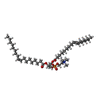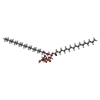[English] 日本語
 Yorodumi
Yorodumi- PDB-9dbm: Full-length apo human voltage-gated sodium channel 1.8 (NaV1.8), ... -
+ Open data
Open data
- Basic information
Basic information
| Entry | Database: PDB / ID: 9dbm | |||||||||
|---|---|---|---|---|---|---|---|---|---|---|
| Title | Full-length apo human voltage-gated sodium channel 1.8 (NaV1.8), class II | |||||||||
 Components Components | Sodium channel protein type 10 subunit alpha | |||||||||
 Keywords Keywords | MEMBRANE PROTEIN / ion channel | |||||||||
| Function / homology |  Function and homology information Function and homology informationbundle of His cell action potential / AV node cell action potential / clathrin complex / regulation of atrial cardiac muscle cell membrane depolarization / membrane depolarization during action potential / voltage-gated monoatomic ion channel activity involved in regulation of presynaptic membrane potential / regulation of monoatomic ion transmembrane transport / sensory perception / cardiac muscle cell action potential involved in contraction / voltage-gated sodium channel complex ...bundle of His cell action potential / AV node cell action potential / clathrin complex / regulation of atrial cardiac muscle cell membrane depolarization / membrane depolarization during action potential / voltage-gated monoatomic ion channel activity involved in regulation of presynaptic membrane potential / regulation of monoatomic ion transmembrane transport / sensory perception / cardiac muscle cell action potential involved in contraction / voltage-gated sodium channel complex / Interaction between L1 and Ankyrins / voltage-gated sodium channel activity / odontogenesis of dentin-containing tooth / Phase 0 - rapid depolarisation / regulation of cardiac muscle contraction / sodium ion transmembrane transport / regulation of heart rate / presynaptic membrane / transmembrane transporter binding / axon / glutamatergic synapse / extracellular exosome / plasma membrane Similarity search - Function | |||||||||
| Biological species |  Homo sapiens (human) Homo sapiens (human) | |||||||||
| Method | ELECTRON MICROSCOPY / single particle reconstruction / cryo EM / Resolution: 3.22 Å | |||||||||
 Authors Authors | Neumann, B. / McCarthy, S. / Gonen, S. | |||||||||
| Funding support |  United States, 2items United States, 2items
| |||||||||
 Citation Citation |  Journal: Nat Commun / Year: 2025 Journal: Nat Commun / Year: 2025Title: Structural basis of inhibition of human Na1.8 by the tarantula venom peptide Protoxin-I. Authors: Bryan Neumann / Stephen McCarthy / Shane Gonen /  Abstract: Voltage-gated sodium channels (Nas) selectively permit diffusion of sodium ions across the cell membrane and, in excitable cells, are responsible for propagating action potentials. One of the nine ...Voltage-gated sodium channels (Nas) selectively permit diffusion of sodium ions across the cell membrane and, in excitable cells, are responsible for propagating action potentials. One of the nine human Na isoforms, Na1.8, is a promising target for analgesics, and selective inhibitors are of interest as therapeutics. One such inhibitor, the gating-modifier peptide Protoxin-I derived from tarantula venom, blocks channel opening by shifting the activation voltage threshold to more depolarized potentials, but the structural basis for this inhibition has not previously been determined. Using monolayer graphene grids, we report the cryogenic electron microscopy structures of full-length human apo-Na1.8 and the Protoxin-I-bound complex at 3.1 Å and 2.8 Å resolution, respectively. The apo structure shows an unexpected movement of the Domain I S4-S5 helix, and VSD was unresolvable. We find that Protoxin-I binds to and displaces the VSD S3-S4 linker, hindering translocation of the S4 helix during activation. | |||||||||
| History |
|
- Structure visualization
Structure visualization
| Structure viewer | Molecule:  Molmil Molmil Jmol/JSmol Jmol/JSmol |
|---|
- Downloads & links
Downloads & links
- Download
Download
| PDBx/mmCIF format |  9dbm.cif.gz 9dbm.cif.gz | 254.9 KB | Display |  PDBx/mmCIF format PDBx/mmCIF format |
|---|---|---|---|---|
| PDB format |  pdb9dbm.ent.gz pdb9dbm.ent.gz | 186 KB | Display |  PDB format PDB format |
| PDBx/mmJSON format |  9dbm.json.gz 9dbm.json.gz | Tree view |  PDBx/mmJSON format PDBx/mmJSON format | |
| Others |  Other downloads Other downloads |
-Validation report
| Summary document |  9dbm_validation.pdf.gz 9dbm_validation.pdf.gz | 2.5 MB | Display |  wwPDB validaton report wwPDB validaton report |
|---|---|---|---|---|
| Full document |  9dbm_full_validation.pdf.gz 9dbm_full_validation.pdf.gz | 2.5 MB | Display | |
| Data in XML |  9dbm_validation.xml.gz 9dbm_validation.xml.gz | 51.4 KB | Display | |
| Data in CIF |  9dbm_validation.cif.gz 9dbm_validation.cif.gz | 72.9 KB | Display | |
| Arichive directory |  https://data.pdbj.org/pub/pdb/validation_reports/db/9dbm https://data.pdbj.org/pub/pdb/validation_reports/db/9dbm ftp://data.pdbj.org/pub/pdb/validation_reports/db/9dbm ftp://data.pdbj.org/pub/pdb/validation_reports/db/9dbm | HTTPS FTP |
-Related structure data
| Related structure data |  46720MC  9dbkC  9dblC  9dbnC M: map data used to model this data C: citing same article ( |
|---|---|
| Similar structure data | Similarity search - Function & homology  F&H Search F&H Search |
- Links
Links
- Assembly
Assembly
| Deposited unit | 
|
|---|---|
| 1 |
|
- Components
Components
-Protein / Sugars , 2 types, 6 molecules A
| #1: Protein | Mass: 225721.281 Da / Num. of mol.: 1 Source method: isolated from a genetically manipulated source Source: (gene. exp.)  Homo sapiens (human) / Gene: SCN10A / Production host: Homo sapiens (human) / Gene: SCN10A / Production host:  Homo sapiens (human) / References: UniProt: Q9Y5Y9 Homo sapiens (human) / References: UniProt: Q9Y5Y9 |
|---|---|
| #2: Polysaccharide | beta-D-mannopyranose-(1-4)-2-acetamido-2-deoxy-beta-D-glucopyranose-(1-4)-2-acetamido-2-deoxy-beta- ...beta-D-mannopyranose-(1-4)-2-acetamido-2-deoxy-beta-D-glucopyranose-(1-4)-2-acetamido-2-deoxy-beta-D-glucopyranose Source method: isolated from a genetically manipulated source |
-Non-polymers , 4 types, 16 molecules 






| #3: Chemical | ChemComp-CLR / #4: Chemical | #5: Chemical | ChemComp-LPE / #6: Chemical | |
|---|
-Details
| Has ligand of interest | N |
|---|---|
| Has protein modification | Y |
-Experimental details
-Experiment
| Experiment | Method: ELECTRON MICROSCOPY |
|---|---|
| EM experiment | Aggregation state: PARTICLE / 3D reconstruction method: single particle reconstruction |
- Sample preparation
Sample preparation
| Component | Name: Sodium channel protein type 10 subunit alpha / Type: COMPLEX / Entity ID: #1 / Source: RECOMBINANT | ||||||||||||||||||||
|---|---|---|---|---|---|---|---|---|---|---|---|---|---|---|---|---|---|---|---|---|---|
| Molecular weight | Experimental value: NO | ||||||||||||||||||||
| Source (natural) | Organism:  Homo sapiens (human) Homo sapiens (human) | ||||||||||||||||||||
| Source (recombinant) | Organism:  Homo sapiens (human) Homo sapiens (human) | ||||||||||||||||||||
| Buffer solution | pH: 7.5 | ||||||||||||||||||||
| Buffer component |
| ||||||||||||||||||||
| Specimen | Conc.: 0.25 mg/ml / Embedding applied: NO / Shadowing applied: NO / Staining applied: NO / Vitrification applied: YES | ||||||||||||||||||||
| Specimen support | Details: negatively glow discharged with the graphene facing up Grid material: GOLD / Grid mesh size: 300 divisions/in. / Grid type: Quantifoil R2/4 | ||||||||||||||||||||
| Vitrification | Instrument: LEICA EM GP / Cryogen name: ETHANE / Humidity: 96 % / Chamber temperature: 283 K |
- Electron microscopy imaging
Electron microscopy imaging
| Experimental equipment |  Model: Titan Krios / Image courtesy: FEI Company |
|---|---|
| Microscopy | Model: FEI TITAN KRIOS |
| Electron gun | Electron source:  FIELD EMISSION GUN / Accelerating voltage: 300 kV / Illumination mode: FLOOD BEAM FIELD EMISSION GUN / Accelerating voltage: 300 kV / Illumination mode: FLOOD BEAM |
| Electron lens | Mode: BRIGHT FIELD / Nominal magnification: 105000 X / Nominal defocus max: 2500 nm / Nominal defocus min: 1000 nm / Cs: 2.7 mm |
| Specimen holder | Cryogen: NITROGEN / Specimen holder model: FEI TITAN KRIOS AUTOGRID HOLDER |
| Image recording | Electron dose: 60 e/Å2 / Film or detector model: GATAN K3 (6k x 4k) / Num. of real images: 13124 |
| EM imaging optics | Energyfilter name: GIF Bioquantum / Energyfilter slit width: 20 eV |
- Processing
Processing
| EM software |
| ||||||||||||||||||||||||||||||||||||||||
|---|---|---|---|---|---|---|---|---|---|---|---|---|---|---|---|---|---|---|---|---|---|---|---|---|---|---|---|---|---|---|---|---|---|---|---|---|---|---|---|---|---|
| CTF correction | Type: PHASE FLIPPING AND AMPLITUDE CORRECTION | ||||||||||||||||||||||||||||||||||||||||
| Symmetry | Point symmetry: C1 (asymmetric) | ||||||||||||||||||||||||||||||||||||||||
| 3D reconstruction | Resolution: 3.22 Å / Resolution method: FSC 0.143 CUT-OFF / Num. of particles: 82542 / Symmetry type: POINT | ||||||||||||||||||||||||||||||||||||||||
| Atomic model building | Details: The initial model consisted of one of our earlier apo models. Source name: Other / Type: experimental model |
 Movie
Movie Controller
Controller





 PDBj
PDBj













